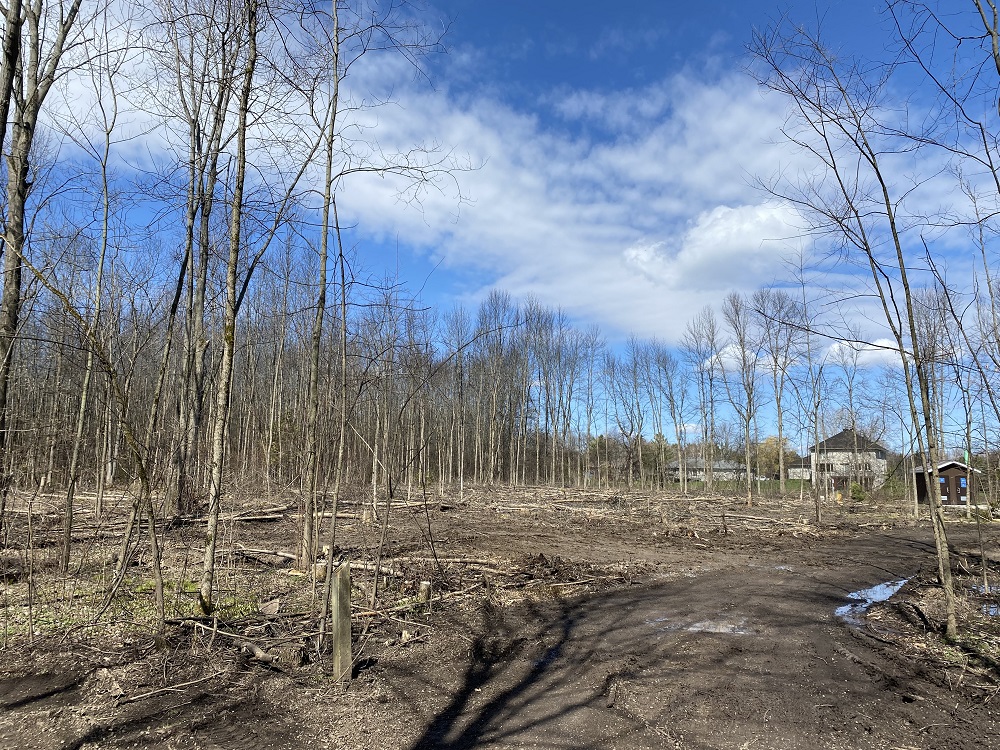
Today’s blog comes from Park Superintendent Scott Thomas and Assistant Park Superintendent Andrea Maranduik of Ontario Parks’ Bass Lake Cluster.
As we prepare for another camping season at Mara Provincial Park and McRae Point Provincial Park, we want to share some important updates regarding the health of our trees and the measures we’re taking to ensure your safety and preserve the natural beauty of the parks.
Because of Emerald Ash Borer – an invasive species that is devastating forests across southern Ontario – we’ve unfortunately had to cut down large swaths of trees at both parks to safeguard the health of our forests and the well-being of our visitors.
If you’re a return visitor to these parks, you’re almost sure to notice. As a result, your camping experience will be affected. Some campsites, for example, will have less privacy and shade.
But we want to assure you that our top priority is the safety of our visitors, our staff, and our parks. We’re working hard to manage our park ecology responsibly.
And it’s not all doom and gloom! The forest will rebound. And there are things you can do to help.
~
The Emerald Ash Borer
You may have heard about the Emerald Ash Borer (EAB) since a number of Ontario Parks have been seriously impacted by this insect.

Identifying infected ash trees is crucial for managing the EAB infestation.

Signs include thinning branches, small D-shaped holes in the bark, and serpentine tunnels beneath the surface of the bark.
Unfortunately, the mortality rate of ash trees infested with EAB is exceptionally high. At Mara and McRae Point, certain areas of the park had dense areas of ash (80-90%).
Once signs are detected, it is only a matter of time until 99% of trees die.
And the signs aren’t always obvious; sometimes a perfectly healthy-looking tree can actually be infested.
Infected trees are weakened and therefore a safety hazard. Large limbs can fall onto campsites, road, and trails.
Over the past winter, we made the difficult decision to cut down thousands of ash trees found within striking distance of campsites, roads, day use areas, and buildings.
This saddened us greatly, as we know it saddens our regular visitors.
~
Grieving the loss of trees
The EAB began its destructive path in Ontario in 2002, so we knew this day was coming.
But that doesn’t make it any easier and we join our visitors in grieving for the forest.

We also didn’t make this decision lightly.
We have been monitoring the ash trees in our parks for years, assessing trees for the presence of EAB.
As this invasive species continued its march across the province, we consulted with numerous ecologists and arborists to devise a response plan. It became apparent that the perfect time to act was this winter because it provided several benefits.

We acted before people or property were harmed.
And removing trees in winter instead of spring or summer meant that migratory birds hadn’t yet returned, so we wouldn’t damage existing nests.
~
Forests rebound
You might notice several trees that were intentionally left cut at a height of 3-4 m. These tall stumps serve as feeding and nesting habitats for woodpeckers. Preserving their habitat is essential for maintaining biodiversity.
You’ll also notice some stumps and branches lying around. Wherever possible, we’ve left these to help the forest begin regenerating. This woody material will break down and provide nutrients for regenerating growth.

This year we will plant cedar trees and carefully monitor the cleared areas for invasive species, like Garlic Mustard or Common Buckthorn, that will try to take advantage of the increased sunlight.
Moving forward, we will develop a responsive replanting plan for the years to come.
~
Planning your trip to Mara and McRae Point
As you plan your visit to Mara or McRae Point, we encourage you to embrace the changes with sunnier campsites and views of Lake Simcoe (at McRae Point), and explore the unique landscape that makes our park special.
There are important things visitors can do to help the fight against invasive species, like cleaning camping and hiking gear, and buying firewood from within or near the park.

If you are a day user who mostly enjoys the beach, your visit may not be much different. But we understand that campers might be shocked at the significant changes.
Some campsites may be closed as we continue to address the EAB.
However, please know that park management, maintenance staff, and park ecologists continue to work tirelessly towards campsite and day use rehabilitation, and to support the forested areas of the park as they rebound.

If you have any questions or concerns, please don’t hesitate to reach out to us. We’re here to ensure your camping experience is nothing short of fantastic.
Thank you for your support and understanding as we navigate these challenges together. We can’t wait to welcome you back to our parks for another memorable camping adventure!


